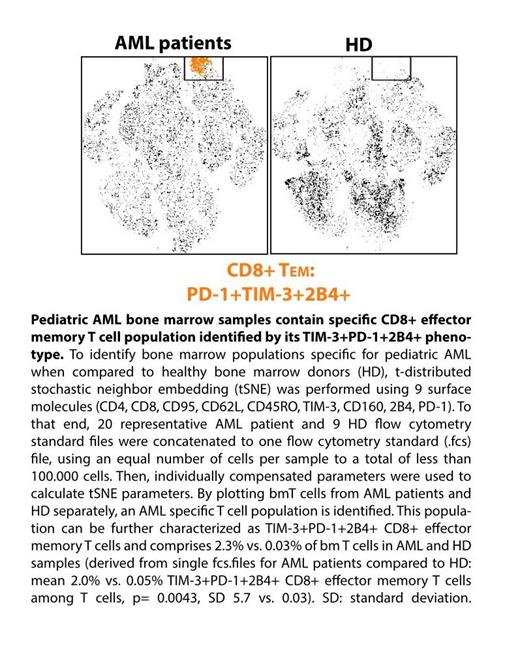Introduction: Despite notable advancements, childhood acute myeloid leukemia (AML) remains associated with one of the poorest prognoses among pediatric malignancies. Conventional chemotherapies carry significant toxicity, underscoring the urgent need for novel e.g. immunotherapy-based approaches. Despite AML being previously considered non-immunogenic due to its low mutational burden, the complex interplay between leukemic blasts and T cells within the bone marrow in pediatric patients remains largely unexplored. This study investigates the AML-induced footprint on local bone marrow T cells (bmT cells) representing tumor-infiltrating lymphocytes, with the aim to reveal functional points of action for future immunotherapy.
Methods: Cryopreserved bone marrow samples from both pediatric AML patients (n=29) and age-matched healthy bone marrow donors (HD, n=9) were analyzed. Multicolor flow cytometry quantified surface expression of inhibitory signaling and activation receptors, as well as T cell differentiation stages. RNA-Seq and Assay for Transposase-Accessible Chromatin using sequencing (ATAC-Seq) were performed of sorted CD8 + bmT cells. Bulk RNA and ATAC-Seq data was visualized by principal component analysis (PCA). Another PCA was performed on the combined dataset of RNA- and ATAC-Seq. Differential analysis using DESeq2 (fitType “parametric”, testType “Wald”) identified 135 differentially expressed genes in CD8 + bmT cells between HD and AML patients based on fold change (≥1/≤-1) and statistical criteria (s-value<0.05).
Results: Based on CD45RO, CD62L and CD95 surface expression, late differentiation stages of bmT cells were enriched in AML. Namely, the frequency of naïve bmT cells was reduced (33.9% vs. 57.5%, mean values, p=0.0018), while the frequency of effector memory bmT cells was increased in AML patients (21.5% vs. 9.4%, p=0.0010). This could be validated by RNA-Seq of sorted CD8 + bmT cells which documented higher expression of cytotoxic effector T cell genes such as Perforin, Granulysin and Granzyme B. In addition, our analysis also revealed higher expression of functional relevant genes associated with T cell cytotoxity (ADGRG1), effector function (BATF/TPX2) or exhaustion (SLAMF7) in AML patients. Next, surface expression of receptors for inhibitory signaling and activation was analyzed. Several of these receptors have also been described as immune checkpoints (ICP). Analyzing differential expression between HD and AML patients showed pronounced upregulation of inhibitory markers (TIM-3: 7.1% vs. 1.7%, p<0.0001, CD39: 7.7% vs. 2.0%, p=0.0103, LAG-3: 8.0% vs. 2.9%; CTLA-4: 3.9% vs. 1.6%, p=0.0024; PD-1: 34.8% vs. 21.3%, p=0.0016). Since CD8 + bmT cells showed the most promising effects in the flow cytometry analysis, this subpopulation of bmT cells was further characterized by RNA- and ATAC-Seq. Here, clustering of HD and AML patients' CD8 + bmT cells was observed in PCA. Interestingly, PCA also revealed differential clustering of CD8 + bmT cells from AML primary and relapse samples. Confirming the observed differences in phenotype of bmT cells in AML patients, we identified distinct bmT cell populations specifically induced in AML patients compared to HD, based on phenotype and differential ICP expression patterns. Through tSNE analysis, we discovered a CD8 + effector memory T cell population with a TIM-3 +PD-1 +2B4 + phenotype, comprising 2.3% of all bmT cells in AML samples compared to only 0.03% in HD.
Conclusion: This study reveals significant alterations in the activation and inhibition potential of bmT cells in pediatric AML compared to HD, as confirmed by comprehensive analysis of the epigenome, transcriptome and surfaceome. We confirm the observed differences through the identification of a T cell population with a typically exhausted phenotype specific for AML patients when compared to HD, implying persistent antigen exposure and potential direct or indirect interactions with leukemic blasts. Although prospective clinical trials will have to confirm functional relevance in patient cohorts, this study provides crucial insights into the immune landscape of pediatric AML, underscoring the potential for targeted immunotherapeutic interventions.
Disclosures
No relevant conflicts of interest to declare.


This feature is available to Subscribers Only
Sign In or Create an Account Close Modal